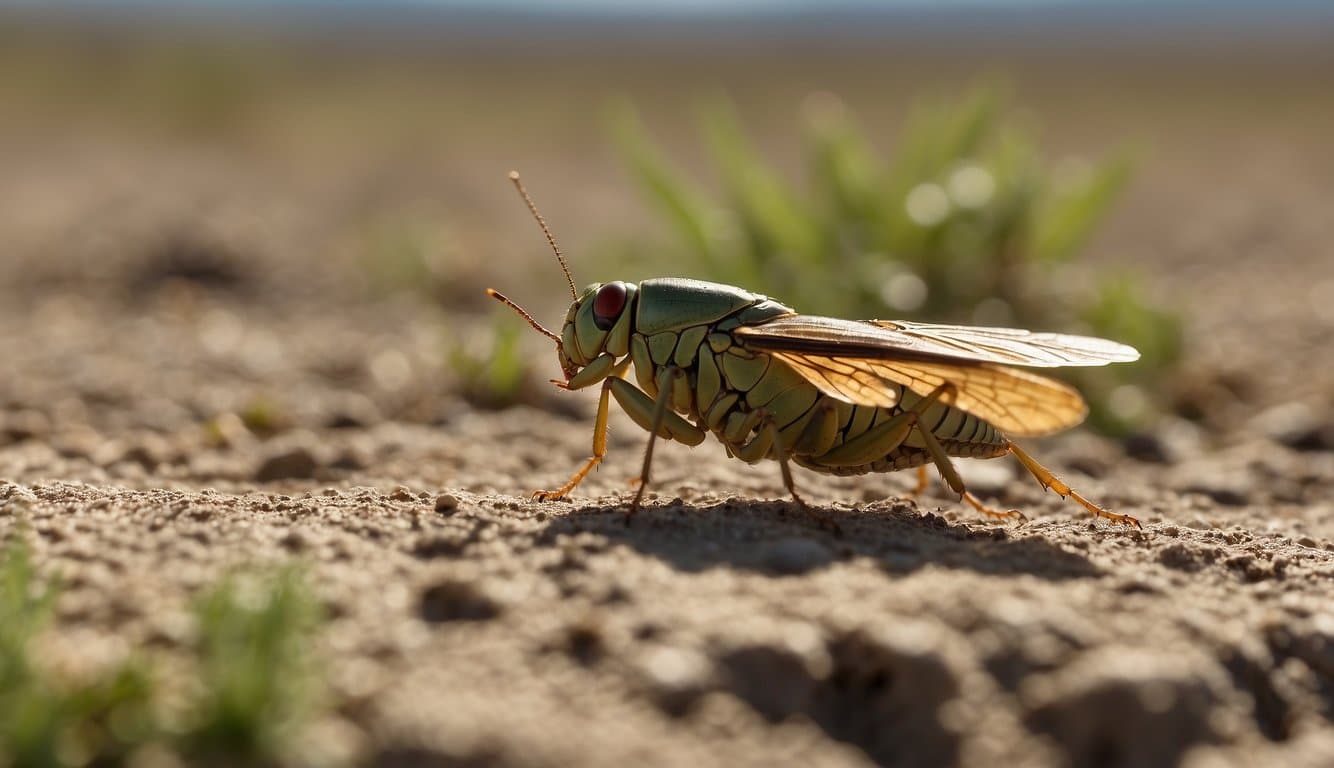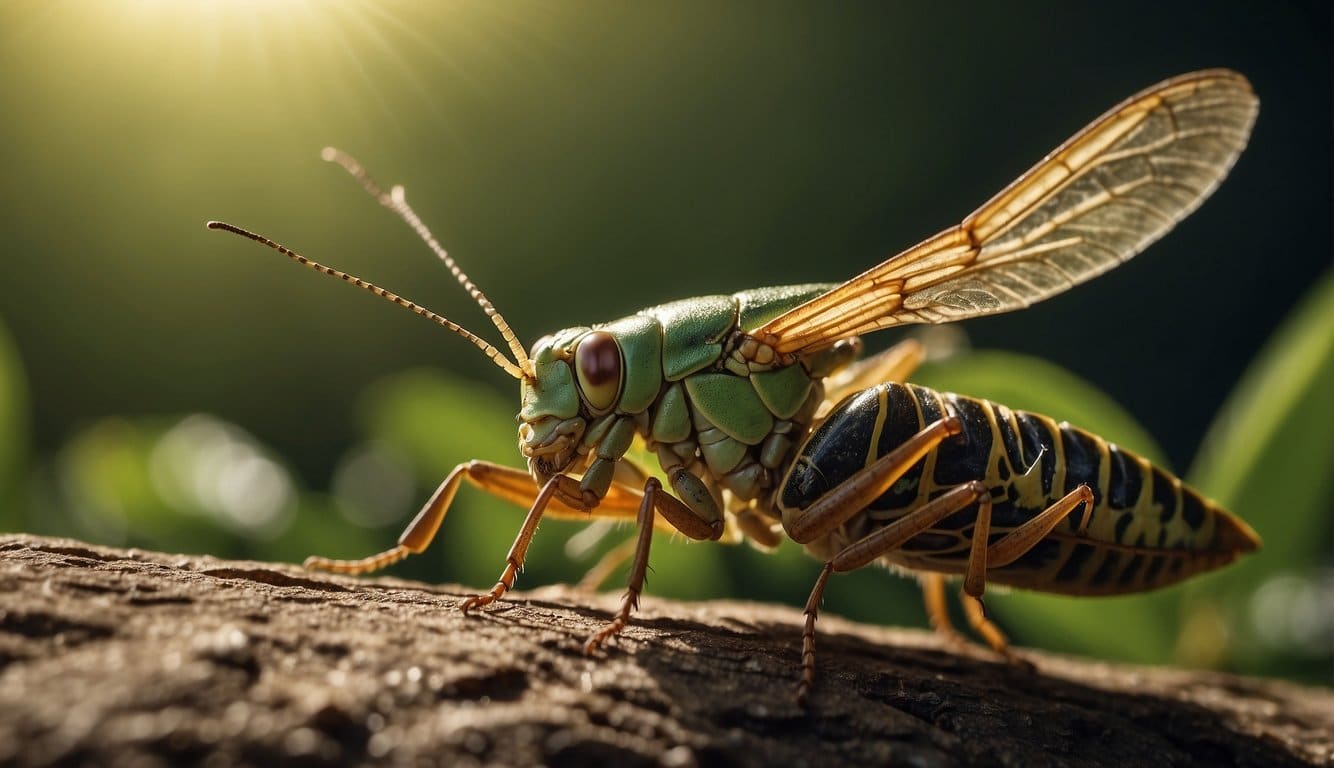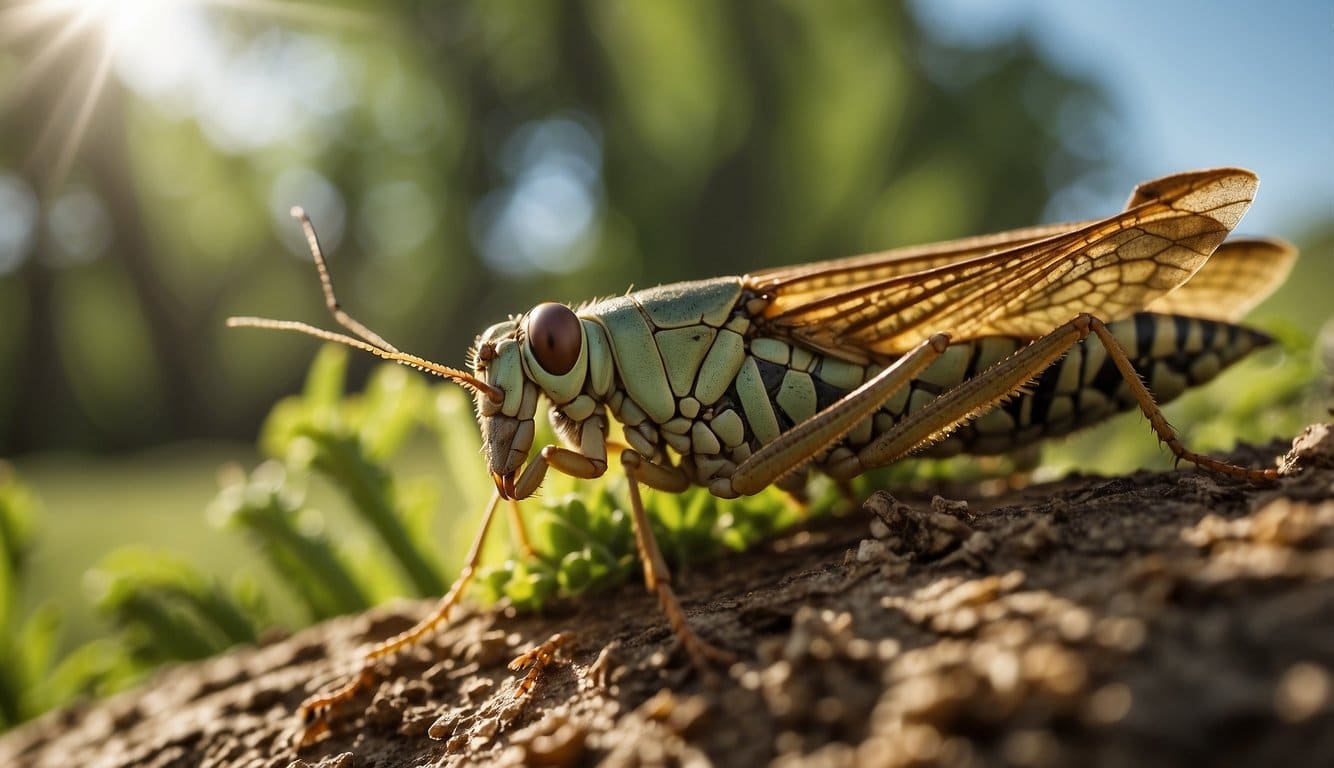Identification Parade: Locusts vs Cicadas
When you’re out enjoying nature, it’s not uncommon to encounter various flying insects. Two that might catch your eye are locusts and cicadas. Knowing your bugs can be a great party trick, and here’s the quick guide to tell them apart! Let’s break it down:
Appearance:
- Cicadas: They boast big, clear wings and a plump, rounded body, often sporting a robust, black or green exterior.
- Locusts: Look for a smaller, more streamlined body with large legs designed for leaping, and typically a yellowish-brown hue.
Sound Off:
- Cicadas are the rock stars of the insect world, known for their loud, signature songs.
- Locusts, on the other hand, can be rather musical but don’t hold a candle to the cicada’s chorus.
Lifestyle:
- Cicadas: You’ll find these guys are either on a strict 17- or 13-year schedule (periodical cicadas) or enjoying life annually (annual cicadas).
- Locusts: Always ready for a party, they can form immense swarms when the conditions are just right, triggered by their knack for social networking.
Diet and Damage:
-
- Cicadas are quite benign, munching on sap and causing minimal damage.
- Locusts embrace a more ‘locust-style’ buffet and can devastate crops and plant life en masse.
| Cicadas | Locusts | |
|---|---|---|
| Body Shape | Rounded | Slim |
| Wings | Clear | Not as prominent |
| Legs | Standard | Large, for jumping |
| Sound | Loud | Quieter |
| Behavior | Solitary / Synchronized Emergence | Swarm Formation |
Next time you’re in the midst of an insect fanfare, use these tidbits to impress your fellow nature enthusiasts. You can find more detailed information on the distinctive sound of cicadas or delve into the key differences between locusts and cicadas. Happy bug spotting!
Life Cycles Unearthed
Nature has orchestrated a fascinating concert of life stages for both locusts and cicadas. You’ll be amazed at how these insects go from egg to maturity with their unique transformative processes.
Egg to Nymph: The Locust Transformation
-
-
- Egg Phase: Your journey through the locust life cycle begins in the ground where a female locust has laid her eggs in a froth-covered cluster. These eggs are resilient, protected from predators and diseases.
- Nymph Stage: About two weeks later, nymphs hatch from these eggs. Unlike butterflies, these nymphs look somewhat like miniature adults, missing only wings and the ability to reproduce. They’ll molt their exoskeletons several times as they grow.
-
Here’s an interesting read on locusts’ early stages at What’s That Bug.
Egg to Adult: The Cicada’s Journey
-
-
- Egg Stage: Initially, as tiny cicada eggs, they’re deposited in the safety of tree bark, set to embark on a journey that’s vastly different from that of the locust.
- Nymph to Adult: After hatching, cicada nymphs burrow into the ground for a prolonged period, which could last several years depending on the type. They eventually emerge as adults, shedding their nymphal skin for the final stage of their life cycle.
-
Discover more about the cicada life cycle at Wildlife Informer.
Songs of the Wild: Communication Techniques
When you’re out in nature, you can’t help but be serenaded by the chorus of insects, with locusts and cicadas being the lead vocalists of the grassy stage. Let’s tune into their methods:
Locusts
-
-
- Sound Source: They rub their legs together or against their wings—a technique known as stridulation.
- Purpose: Primarily to attract a mate; can sometimes intimidate predators.
- Volume: Generally modest, but in a swarm, the collective sound can be quite noticeable.
-
Cicadas
-
-
- Sound Source: Cicadas are the rock stars with built-in amplifiers called tymbals, on the sides of their abdominal base.
- Harmony: Only male cicadas sing to woo the silent females.
- Volume: These little guys can belt a tune up to 100 decibels; their mating calls can drown out a lawn mower!
-
| Insect | Method of Sound Production | Purpose of Song | Relative Volume |
|---|---|---|---|
| Locust | Stridulation | Mating, Intimidate | Moderate to Loud |
| Cicada | Tymbals | Mating | Very Loud |
Take note, when you’re hiking your favorite trail or just chilling in your backyard, keep an ear out — you might just be audience to the most natural, buzz-worthy concert in town! And remember, those sounds aren’t just noise; they signify life, love, and communication in the insect world. Keep listening, and you’ll become a seasoned concertgoer of the great outdoors in no time.
Feast or Famine: Dietary Habits
When you’re out and about in the natural world, it’s crucial to distinguish who’s who at the dining table of the ecosystem. Let’s chow down on the facts:
-
-
- Cicadas: Love to sip on tree sap. Here’s their idea of a juice cleanse—tapping into the xylem of deciduous trees to drink up nutrients.
- Locusts: These guys are the ultimate vegans, chomping down on green leaves en masse. They’re known to devour crops, creating a literal famine for farmers.
-
Cicada Diet Specials:
-
-
- Sap: The main course, with a side of bark.
- Food Source: Deciduous trees such as oak and willow.
-
Been to a sizzling summer cicada concert? That’s them calling over the buffet!
Locust Menu Must-haves:
-
-
- Leaves: A leafy green platter, with a spicy dusting of crops.
- Feeding Frenzy: These critters don’t stop. A swarm is like a buffet turned food fight.
-
Met a swarm of locusts on their feeding spree? You’ve seen nature’s all-you-can-eat in its true glory.
Coping with the Swarm: Environmental Impact
When you witness a cicada or locust swarm, it’s not just an impressive sight; it has profound implications for your local ecosystem. Here’s a quick breakdown of what that impact looks like:
Cicadas:
-
-
- Soil Enrichment: Your soil gets a boost when cicadas emerge. They aerate the soil during their mass exit.
- Food Source: Birds, fish, and other wildlife feast on cicadas, making these insects a significant addition to the food chain.
- Plant Pruning: Some twigs and stems may die off due to cicadas laying eggs, which can stimulate new plant growth.
-
However, an article from Vox highlights that cicada activities can rewire ecosystems, influencing forest food webs for years to come.
Locusts:
-
-
- Crop Destruction: In contrast, locust swarms are infamous for devouring crops, potentially leading to food shortages.
- Economic Damage: Your local agricultural economy can suffer greatly if a locust swarm descends on farmlands.
-
For coping strategies, consider:
-
-
- Proactive Monitoring: Keep an eye on swarm predictions to prepare in advance.
- Natural Predators: Encourage the presence of locust-eating animals in your area.
- Expert Consultation: Contact local agricultural experts for advice on safeguarding plants.
-
Frequently Asked Questions
In this section, you’ll find answers to some buzzing questions about locusts and cicadas – from their noisy sounds to their emergence patterns and environmental impacts.
What distinguishes the sounds made by locusts and cicadas?
Cicadas are known for their distinct, often deafening, sounds used to attract mates.
These sounds are produced using special structures called tymbals found on their abdomens.
In contrast, locusts generate softer chirping sounds and lack the tymbals that cicadas use for their acoustic performances.
Are cicadas and locusts expected to emerge in large numbers in 2024?
While locust swarming events depend on certain environmental triggers, periodical cicadas are indeed expected to emerge in massive numbers at predictable intervals of 13 or 17 years.
This may align with 2024 for specific broods.
How can you tell apart a locust shell from a cicada exuviae?
When cicadas molt, they leave behind exuviae, a shell that is a near-perfect replica of their former selves.
You can distinguish a cicada exuviae by its split down the back where the insect emerged.
Locust shells are less common, as locusts do not leave such distinctive molts but rather undergo gradual change.
What are the main differences between cicadas, locusts, and katydids?
Cicadas are famed for their periodic emergences and are not related to locusts, which are a type of grasshopper that can form destructive swarms.
Katydids, with their leaf-like wings, are more closely related to grasshoppers and crickets.
They are usually green and mimic leaves, differing from the brown or black hues often seen in swarming locusts.
How often do cicadas emerge compared to locust swarms?
Cicadas have a predictable emergence pattern, with annual species appearing every year and periodical species surfacing in large numbers every 13 to 17 years.
Locust swarms are less predictable and can occur in response to specific environmental changes, such as heavy rains following drought.
Can cicadas cause any harm to the environment or people?
Cicadas themselves are harmless to humans and do not bite or sting.
While their egg-laying process can cause minor damage to young trees, cicadas generally are not harmful to the environment and actually play a role in the nutrient cycle.
Locust swarms, however, can devastate crops and have significant economic impacts on agriculture.


